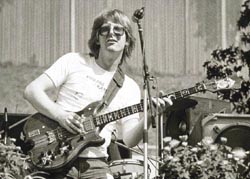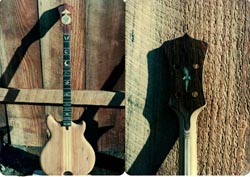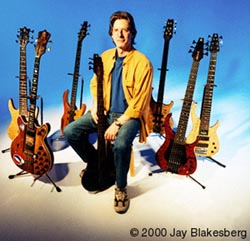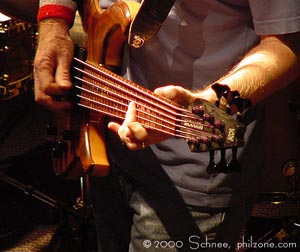B I O G R A P H Y

Phillip Chapman Lesh was born on March 15, 1940 in Berkeley, California.
Phil
Lesh's began playing the trumpet when he was fourteen years old, having
grown up being exposed to jazz greats such as John Coltrane and Miles
Davis. Lesh enrolled at UC Berkeley to become a music major, but he and
a friend, Tom Constanten, quickly became appalled by the music department's
tendency to discourage individual creativity.
Midway through his first semester at Berkeley, Lesh dropped out of college.
Lesh enrolled himself in composer, Luciano Berio's class at Mill's College
where he was finally given the opportunity to compose his own music. The
following summer, Lesh returned to California where he met Garcia and
Pigpen in Palo Alto. Once, in Kepler's bookstore, Lesh heard Garcia play
banjo and Lesh asked him to play on the radio show that Lesh was an engineer
for. Quickly, the two became friends.
One night in 1965, Lesh, Garcia, and Weir all happened to be at the same party in Palo Alto. While in Garcia's car, smoking pot, Lesh mentioned that he was interested in taking up an electric instrument, maybe the bass. Lesh attended the Warlocks next gig and was invited to play bass with them. After playing a few more gigs, the combination of talent became indelible.
Big thanks to M. Schmidt for the portion above.
He made a significant contribution to If I Could Only Remember My Name, David Crosby's 1971 solo debut. In 1975, Lesh completed Seastones, an experimental collaboration with electronics wizard Ned Lagin. Described as "cybernetic bio-music" by a contemporary newsletter, the set used a battery of technological gadgets and computers to create impressionistic patterns of sound. Jerry Garcia, Grace Slick and David Crosby appeared on the project, but their contributions were masked by layers of treated effects. Lesh and Lagin also made live appearances showcasing similar material, but the bassist pursued a more orthodox sideline with Too Loose To Truck, a bar-band specializing in cover versions. Despite these outside activities, Lesh's strongest work has been made within the core of the parent group, none better highlighted than on "Dark Star" from Live Dead.
Big thanks to Encyclopedia of Popular MusicCopyright Muze UK Ltd. for the above portion.
Famed for his three-decade stint as the bassist with the Grateful Dead, Phil Lesh was born March 15, 1940 in Berkeley, CA; rooted in jazz and classical performance, he initially explored the violin and trumpet, and while attending Mills College studied avant-garde composition and electronic music under the tutelage of Luciano Berio. In 1965, Lesh joined his friend Jerry Garcia's band the Warlocks, soon rechristened the Grateful Dead. He remained with the group for the remainder of its existence, becoming a fan favorite as much for his distinctive bass playing as for his single-minded devotion to the Dead's music (no long-term side projects) and custodianship of their recorded archives, overseeing the quality of each legitimate live release. After Garcia's 1995 death spelled the end of the Dead as a touring entity, Lesh reunited with bandmates Bob Weir and Mickey Hart in the Other Ones, which headlined the 1998 Further Festival. Later that year he learned he was in need of a liver transplant, successfully undergoing surgery in December. The Sunday before he went under, Deadheads across the globe joined in Five Minutes for Phil, a worldwide prayer circle he later credited as a major factor in his speedy recovery. [Phil and Friends was born in 1998.] Lesh hit the road in 1999 as headliner, issuing his solo debut Love Will See You Through in the autumn.
Big thanks to Jason Ankeny, All Music Guide, for the portion above.
You know the rest ;-)
Bass History by Edwin Hurwitz
The short story is this: Phil started out on a Gibson EB0, then moved to a Fender Jazz Bass which he used until '68. After that he played a not very modified Guild Starfire (preamps and some magnet changes in the pickups) through late '69 or so (Live Dead is a great example of this sound). The next bass was a heavily modified Gibson EB3 (I think it was a long instrument) which had new hardware, preamps and Guild single coil pickups installed by Alembic. This bass can be heard on Skullfuck and other recordings of the time (DP from the Fillmore '70 show is an excellent example of this instrument). This instrument was stolen (anybody out there seen it?) and was followed by the Starfire, but this time it had it's front removed and replaced with all new pickups and electronics, including an Alembic superfilter and quadraphonic pickup. The headstock was also replaced. It was called the Godfather. This is the bass heard on Europe '72 and in a lot of ways my favorite of Phil's various sounds. It can be seen at Alembic's website. In '73 he received his first Alembic 4 string bass that was also quite an instrument, it was also quad and is seen in the Grateful Dead movie. It interfaced quite well with the Wall of Sound. This bass was followed by a Doug Irwin and then a G&L as well as Flirtations with an old Fender Jazz. Finally, in the early 80s he got his first Modulus 6 string.

Phil
& his Alembic Osage Orange Bass
As far as amplification goes, Phil used various amps in the 60s before settling on Fender Dual Showmen, which were probably somewhat modified by Bear and Alembic. By mid 1972 he started using these amps in conjunction with McIntosh 3500 tube amps (these can be clearly seen in the Sunshine Daydream video from August of '72). Each amp produced 350 watts from 8 6L6GC tubes, which, if you use 4 of these, can create an awesome sound indeed. Shortly thereafter, Alembic convinced him (I'm sure it was very easy) to use their F2B preamps instead of the Fender front ends. These preamps are awesome and are still made today. He also switched to McIntosh 2300s, which, as solid state amps, are much more efficient in terms of weight and reliability. This was the electronic basis for his part of the Wall of Sound and remained the center of his rig through to the late 70s with various configurations of speakers (starting out with JBLs in the late 60s to Gauss by the late 70s). Eventually he switched to a Groove Tubes preamp and Crest amps and developed a rig that was dominated by the Meyer processors and speakers for a very hifi sound that was essentially a miniature version of the PA system used throughout the 80s and 90s.

Phil's
Alembic Osage Orange Bass Under Construction
(Circa 2000) Phil now uses a Modulus 6-string with thru-body neck- EMG pickups and a wireless rig, Eden pre-amp, Meyer Sound Labs custom-configured amp stack.

